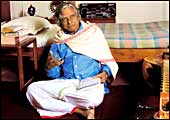|
With
12 ministers of Tamil origin at the centre, it seems only apt that
this column look at the veshti, a piece of cloth that is approximately
3.65 square metres long, which is wrapped around the waist, sarong
style. And it seems even more apt that, down in Tamil Nadu, there
is a genus of the garment called 'Minister veshti', replete with
borders in party colours. Ministers belonging to the Dravida Munnetra
Kazhagam sport veshtis with red and black borders; those owing affiliation
to the dmk's bitter rival All India Anna Dravida Munnetra Kazhagam
sport ones with black, white and red borders; the Pattali Makkal
Katchi's cadres prefer ones with a wide green border bisected by
a thin yellow line and with a thin red line on top.
The best-known of all Minister veshti brands
is Sarathy, from the temple-town of Madurai in Tamil Nadu. Finance
Minister Chidambaram, however, doesn't wear a Minister veshti. He
prefers a variety called Paramas that is all but borderless; it
boasts a border, but the weave is in white, and cannot be noticed.
In a country as given to symbolism as India,
it isn't surprising that the polity should choose to wear white.
The jump from that to what is called national dress, the kurta-pajama,
the dhoti, and the veshti is but a hop and skip away (although people
dressed thus would definitely have a problem hopping or skipping).
After all, white slacks belong in the navy, the judiciary, hotels,
and the front seats of cars. The corollary, or angavastram-a matched
accompaniment to the veshti, another piece of cloth, albeit smaller,
usually worn like a shawl around the shoulders-to that theory about
symbols is that only spotless white will do. Indian politicians
wear kurtas and veshtis that are spotlessly white (wonder why detergent
advertisers give both a miss; the connection is pretty obvious).
Veshtis are bleached, and bleached, and then re-bleached, till they
are spotlessly white. The Sarathy veshti, for instance, hurts the
eye with its sheer whiteness.
|

|
|
President A.P.J. Abdul Kalam:
As presidential as it gets
|
 |
| Murugappa Group's M.V. Subbiah:
Power-dresser |
Apart from politicians, most South Indian men
wear veshtis for comfort, and on formal occasions. It isn't easy
keeping one's veshti on, and that could be one reason for the younger
generation to eschew the garment. Belts help-these range in colour
from the conservative black or brown to the trendy white, and could
veer towards bilious sea green in some cases; most have pockets
for money-and one innovative company has launched veshtis with Velcro
pads to obviate the need for a belt. Handloom veshtis rule (polyester
ones that once threatened to overwhelm the market are now almost
extinct and silk ones are worn only during weddings or by the very
very rich), as do fashion trends. Chiffon veshtis, for instance,
are now in with the happening crowd in the South.
Veshtis with gold thread woven into the borders
(zari veshtis) are worn largely during weddings or other functions.
At South Indian weddings, the groom invariably sports a veshti with
a mayilkannu (peacock's eye, literally; semantically, the Tamil
word for the colours on the plumage of the bird) border; it has
a maroon zari border on one side and a green one on the other, and
can be worn any side up. Zari veshtis could cost anything from Rs
400 for one with a thin gold line to Rs 5,000 (for a four-inch gold
border). Chennai's Nalli Chinnasami Chetty Store has a silk veshti
that retails for Rs 10,000 but it is meant exclusively as an offering
to the reigning deity of Tirupati, Balaji. Go ahead, try a veshti;
it's your one chance to wear the garment of the Gods.
|
